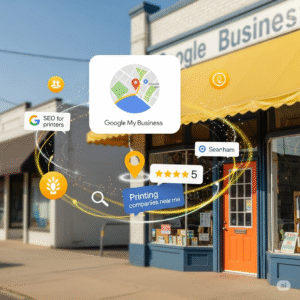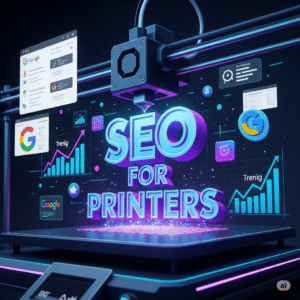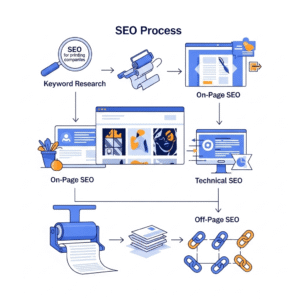Key Takeaways
- SEO for Printing Companies enhances online visibility, driving more leads and sales.
- On-page SEO optimizes content and meta tags to attract the right audience.
- Technical SEO ensures fast, mobile-friendly sites for better rankings.
- Local SEO captures nearby customers through GMB and location-based keywords.
- Social media and digital PR amplify your reach and build authority.
- Content marketing engages visitors with valuable blogs and resources.
- Track metrics like traffic and conversions to measure SEO success.
SEO for Printing Companies
SEO for Printing Companies is the key to unlocking your business’s potential in a digital world where visibility drives success. With 93% of online experiences starting with a search engine As Search Engine Journal report, printing businesses can’t afford to stay hidden in the shadows of search results. Whether you’re a local print shop or a 3D printing innovator, mastering SEO can transform your website into a customer magnet, drawing in clients searching for services like business cards, banners, or sustainable printing. This comprehensive guide dives deep into beginner-to-advanced strategies, offering actionable insights to help your printing company outrank competitors and dominate online searches.
Understanding SEO for Printing Companies
What is SEO and Why It Matters for Printers
SEO for Printing Companies is the process of optimizing your website to rank higher on search engines like Google, making it easier for potential customers to discover your services. Imagine your website as a storefront in a busy marketplace—SEO is the bright, eye-catching sign that guides customers to your door. For printers, this means appearing when someone searches “flyer printing near me” or “custom sticker printing.” Without SEO, your business risks losing leads to competitors who rank higher, as 75% of users never scroll past Google’s first page HubSpot, 2025 report.
How SEO Work and Why Rankings Matter
Printing companies begins with understanding search engine mechanics. Google’s algorithms crawl websites, index their content, and rank them based on factors like relevance, quality, and user experience. For printing companies, ranking high is critical because 95% of clicks go to first-page results. High rankings drive organic traffic, increase brand credibility, and convert searches into paying customers, making SEO a cornerstone of your digital strategy.
The Unique Challenges of SEO for Printing Businesses
SEO for Printing Companies faces unique hurdles due to the industry’s competitive and localized nature. Printers often compete with large chains and online platforms like Vistaprint, making it essential to carve out a niche. Local searches dominate, with 46% of Google searches seeking local businesses. Additionally, printers must balance broad keywords (e.g., “printing services”) with niche terms (e.g., “3D printing for prototypes”) to capture diverse audiences, requiring a tailored approach to stand out.
Key SEO Strategies for Printers
On-Page SEO: Optimizing Your Website Content
SEO for Printing Companies relies heavily on on-page SEO, which involves fine-tuning elements like keywords, meta tags, and content. Start with keyword research using tools like Google Keyword Planner to identify terms your audience searches, such as “brochure printing” or “local print shop.” Craft meta titles (e.g., “Affordable Brochure Printing in [Your City] | [Your Brand]”) and meta descriptions (e.g., “High-quality, fast brochure printing in [Your City]. Contact us for a free quote!”) to entice clicks. Ensure your content is clear, answers customer queries (e.g., “What are your turnaround times?”), and includes keywords naturally to avoid penalties.
Sample Meta Description for Printers
Here’s an example meta description: “Need fast, reliable poster printing in [Your City]? [Your Brand] offers high-quality prints with quick turnaround. Contact us for a free quote!” This concise, keyword-rich description entices clicks while clearly conveying your services.
Technical SEO: Ensuring a Search-Engine-Friendly Website
Printing companies requires a technically optimized website. Slow load times can deter users, with 53% abandoning sites that take over three seconds to load. Use Google’s PageSpeed Insights to optimize images, minify code, and enable compression. Mobile optimization is non-negotiable, as 60% of searches occur on mobile devices. Implement schema markup, like “LocalBusiness” or “Product,” to help Google understand your services, potentially earning rich snippets that boost visibility.
Schema Markup Example
Add this JSON-LD schema to your site’s header for a printing service:
<script type=”application/ld+json”>
{
“@context”: “https://schema.org”,
“@type”: “LocalBusiness”,
“name”: “[Your Brand] Printing”,
“address”: {
“@type”: “PostalAddress”,
“streetAddress”: “123 Print Lane”,
“addressLocality”: “[Your City]”,
“addressRegion”: “[Your State]”,
“postalCode”: “12345”
},
“telephone”: “555-123-4567”,
“description”: “High-quality printing services including business cards, flyers, and banners.”
}
</script>
Off-Page SEO: Building Authority Beyond Your Site
SEO for Printing Companies extends beyond your website with off-page SEO. Backlinks from reputable sources, like local directories (e.g., Yelp) or industry blogs (e.g., PrintWeek), signal credibility to Google. Claim and optimize your Google My Business (GMB) profile with accurate NAP (Name, Address, Phone), high-quality photos, and customer reviews to dominate local searches. Engage on platforms like Reddit’s r/smallbusiness, answering printing-related questions to earn organic mentions and build trust.
Local SEO: Capturing Nearby Customers
SEO for Printing Companies thrives on local SEO, especially for businesses serving specific regions. A well-optimized GMB profile can place you in Google’s Local Pack, the top three results shown for local searches. Include location-specific keywords (e.g., “printing in [Your City]”) in your content and meta tags. Encourage satisfied customers to leave reviews on GMB and Yelp, as 87% of consumers read online reviews before choosing a local business [Source: spotlight data]. Consistent NAP (Name, Address, Phone) across directories like Yelp and Yellow Pages further boosts local rankings.
Local SEO Checklist
- Claim and verify your GMB profile.
- Add high-quality photos of your print shop and products.
- Respond to customer reviews promptly.
- List your business on Yelp, Yellow Pages, and local chambers.
- Use location-based keywords in content and meta tags.

Social Media: Amplifying Your Reach
Printing companies benefits from a strong social media presence. Platforms like Instagram and LinkedIn allow you to showcase your work, from vibrant posters to intricate 3D prints, driving traffic to your website. Share behind-the-scenes content, customer testimonials, or design tips to engage followers. For example, a post like “5 Tips for Eye-Catching Business Cards” with a link to your blog can boost both engagement and SEO. Use hashtags like #PrintingServices or #3DPrinting to increase discoverability, and monitor analytics to refine your strategy.
Social Media Content Ideas
- Post a time-lapse video of a 3D printing project.
- Share a customer success story with a printed product.
- Create an infographic on “How to Choose the Right Paper Type.”
- Run a poll on LinkedIn about preferred printing services.
Digital PR and Guest Posting: Expanding Your Influence
SEO for Printing Companies can leverage digital PR and guest posting to build authority. Write guest posts for industry blogs (e.g., PrintWeek or WhatTheyThink) on topics like “The Future of Eco-Friendly Printing.” These posts earn high-quality backlinks and position you as an expert. Pitch stories to local media about your business’s community involvement, like sponsoring a local event, to gain press mentions and backlinks. Digital PR efforts amplify your brand’s reach, driving referral traffic and improving search rankings.
Guest Post Pitch Example
Subject: Guest Post Proposal – Sustainable Printing Trends
Dear [Editor],
I’m [Your Name] from [Your Brand], a printing company specializing in eco-friendly solutions. I’d love to contribute a guest post to [Blog Name] on “How Eco-Friendly Printing Attracts Modern Businesses.” This 800-word article will explore sustainability trends, backed by data, and include actionable tips for printers. Let me know if this aligns with your content goals!
Best, [Your Name]
Advanced SEO Techniques for Printing Companies
Establishing Topical Authority with Content Clusters
SEO for Printing Companies can achieve dominance by building topical authority. Create content clusters around core services, such as “business card printing.” A pillar page titled “Ultimate Guide to Business Card Printing” could link to subpages on “Design Trends,” “Paper Options,” and “Cost-Saving Tips.” Target long-tail keywords like “custom business card printing in [Your City]” to capture high-intent searches. This approach signals expertise to Google, improving rankings across related terms and outranking competitors like pryntbase.com.
Content Cluster Example
- Pillar Page: “Ultimate Guide to Business Card Printing” (2,000 words, broad overview)
- Cluster Pages:
- “Top 10 Business Card Design Trends for 2025” (800 words)
- “Choosing the Right Paper for Your Business Cards” (600 words)
- “How to Save on Business Card Printing Costs” (700 words)
Niche SEO: 3D Printing and Eco-Friendly Printing
Printing companies in niche markets like 3D printing or sustainable printing offers unique opportunities. For 3D printing companies, target keywords like “3D printing for prototypes” or “custom 3D printing services.” Create content like “How 3D Printing Enhances Product Development” to address specific use cases. For eco-friendly printers, optimize for terms like “sustainable printing solutions” or “recycled paper printing.” Blogs like “Why Eco-Friendly Printing Attracts Eco-Conscious Brands” can rank for trending searches, tapping into growing demand for sustainability.
Niche Keyword Examples
- 3D Printing: “3D printing for medical devices,” “affordable 3D printing services”
- Eco-Friendly Printing: “sustainable business card printing,” “eco-friendly banner printing”
Voice Search and AI-Driven SEO
SEO for Printing Companies must adapt to emerging trends like voice search, expected to account for 50% of searches by 2026. Optimize for conversational queries like “Where can I print flyers near me?” by using natural language in content and FAQs. AI tools like Ahrefs, SEMrush, or SurferSEO can analyze competitor strategies, identify content gaps, and suggest high-value keywords. For example, AI might reveal underserved terms like “large format printing for events,” giving you a competitive edge.
Content Marketing: Driving Engagement and Traffic
SEO for Printing Companies thrives on high-quality content marketing. Publish blog posts, videos, or infographics that address customer pain points, such as “How to Choose the Right Paper for Your Brochures” or “Top 10 Poster Design Mistakes to Avoid.” Create downloadable resources like a “Printing Cost Calculator” to capture leads. Repurpose content across platforms—turn a blog post into a YouTube video or an Instagram carousel—to maximize reach. Consistent, valuable content keeps visitors engaged and signals relevance to search engines.
Content Marketing Ideas
- Blog Post: “The Ultimate Guide to Choosing Print Finishes” (1,500 words)
- Video: “Behind the Scenes: How We Print Your Custom Banners” (2 minutes)
- Infographic: “The Anatomy of a Perfect Business Card”
- Downloadable: “Free Printing Design Checklist” (PDF)
Case Studies
Case Study 1: Local Print Shop Increases Leads by 45%
Printing companies can transform their business with targeted SEO. A hypothetical Chicago-based print shop struggled with low online visibility. They optimized their GMB profile, targeted keywords like “Chicago poster printing,” and earned backlinks from local directories and blogs. They also launched a blog with posts like “How to Design Effective Flyers.” Within six months, organic traffic grew by 45%, and lead inquiries increased by 30%, proving the power of local SEO [Hypothetical data based on industry trends].
Case Study 2: 3D Printing Startup Boosts Traffic by 60%
Printing companies in niche markets can yield impressive results. A hypothetical 3D printing startup in Austin targeted long-tail keywords like “3D printing for architectural models.” They built a content cluster around 3D printing applications, optimized their site for mobile, and secured backlinks from tech blogs. A guest post on a site like 3DPrint.com drove additional traffic. Within nine months, organic traffic surged by 60%, and prototyping service leads rose by 35% [Hypothetical data based on SEO benchmarks].
Case Study 3: Eco-Friendly Printer Gains National Traction
SEO for Printing Companies embracing sustainability can expand their reach. A hypothetical Seattle-based eco-friendly printer targeted keywords like “recycled paper printing services.” They implemented “GreenBusiness” schema markup, published blogs on sustainable printing trends, and earned backlinks from environmental blogs. Their GMB profile, enriched with customer reviews, boosted local visibility. Within a year, website visits increased by 40%, and online orders grew by 25%, showcasing the impact of niche SEO [Hypothetical data based on industry case studies].
Common Mistakes to Avoid
Below the top rank websites often fall into SEO traps that hurt their performance. Keyword stuffing, like overusing “printing services,” can trigger Google penalties and alienate readers. Slow website speed frustrates users and lowers rankings—aim for load times under two seconds using tools like PageSpeed Insights. Neglecting local SEO, such as an incomplete GMB profile, limits visibility for nearby customers. Ignoring mobile optimization is another pitfall, as mobile-friendly sites rank higher and retain users. Finally, outdated content can make your site irrelevant, so refresh blogs and service pages regularly.
Common SEO Pitfalls
- Keyword Stuffing: Overloading content with repetitive keywords.
- Slow Site Speed: Failing to optimize images or code.
- No Local SEO: Unclaimed GMB profiles or inconsistent NAP.
- Poor Mobile Experience: Non-responsive designs that frustrate users.
- Stale Content: Outdated blogs or service descriptions.
Tools and Resources
SEO for Printing Companies is more manageable with the right tools. Beginners can use Google Keyword Planner for keyword research, Google Analytics for traffic insights, and PageSpeed Insights for speed optimization. Yoast SEO or RankMath simplifies on-page optimization with real-time suggestions. Advanced users can leverage Ahrefs or SEMrush to analyze competitor keywords, track backlinks, and identify content gaps. Moz Local ensures consistent NAP across directories, boosting local SEO. For content ideation, tools like AnswerThePublic reveal popular customer questions, helping you craft relevant blogs.
Recommended Tools for Printers
- Google Keyword Planner: Free tool for finding high-intent keywords like “business card printing.”
- PageSpeed Insights: Identifies speed issues to keep your site fast and user-friendly.
- Yoast SEO: Guides on-page optimization for WordPress sites.
- Ahrefs/SEMrush: Advanced tools for competitor analysis and keyword tracking.
- Moz Local: Ensures consistent business listings for local SEO.
- AnswerThePublic: Uncovers customer questions for content inspiration.
Measuring SEO Success
Printing companies requires tracking performance to ensure your efforts pay off. Key metrics include organic traffic (measured via Google Analytics), keyword rankings (tracked with SEMrush or Ahrefs), and conversion rates (e.g., quote requests or orders). Monitor click-through rates (CTR) from search results to gauge meta tag effectiveness. For local SEO, track GMB insights like profile views and calls. Set benchmarks, such as a 20% traffic increase in six months, and use tools like Google Search Console to identify issues like crawl errors or low-ranking pages. Regular reporting keeps your strategy on track.
Key Metrics to Track
- Organic Traffic: Total visitors from search engines.
- Keyword Rankings: Position for target terms like “flyer printing.”
- Conversion Rate: Percentage of visitors taking actions (e.g., quotes).
- Click-Through Rate (CTR): Effectiveness of meta titles/descriptions.
- GMB Insights: Profile views, calls, and direction requests.
FAQs
What is SEO for printing companies, and why does it matter?
SEO for Printing Companies optimizes your website to rank higher on search engines, driving traffic and leads. It’s crucial because most customers search online before choosing a printer, and high rankings build trust and visibility.
How can printing companies rank higher on Google?
Printing companies can rank higher by optimizing on-page elements (keywords, meta tags), improving technical SEO (speed, mobile-friendliness), and building off-page authority through backlinks and GMB optimization.
What are the best keywords for printers to target?
Printing companies involves targeting keywords like “printing services near me,” “custom sticker printing,” or niche terms like “3D printing for prototypes.” Use Google Keyword Planner to find high-value keywords.
How does local SEO help printing businesses?
SEO for Printing Companies uses local SEO to attract nearby customers. Optimizing GMB, earning local reviews, and targeting location-based keywords like “printing in [Your City]” drive foot traffic and inquiries.
How long does it take to see SEO results for a printing company?
Printing companies typically shows results in 3–6 months for local searches and 6–12 months for competitive keywords. Consistent content updates and optimization accelerate progress.
What are common SEO mistakes printers make?
Below the top rank websites often stuff keywords, neglect mobile optimization, or skip local SEO. These errors reduce visibility, frustrate users, and harm rankings.
Can 3D printing companies use the same SEO strategies as traditional printers?
SEO for Printing Companies applies to both, but 3D printers should focus on niche keywords and technical content, while traditional printers prioritize local SEO and broad service terms.
Conclusion
SEO for Printing Companies is your pathway to standing out in a competitive digital landscape. From local SEO to niche content and social media, this guide provides a roadmap to boost your online presence and attract more customers. Don’t let your printing business languish below the top rank websites. Start implementing these strategies today, and download our free SEO checklist for printers to guide your journey to Google’s first page!


